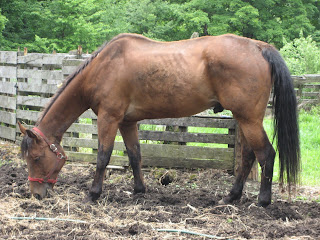Well, here is what a few groceries and some good wormer will do in just 6 weeks. This was the middle of June....
Now, almost to the end of September .... this picture was taken this morning in the field at my house.
He still has a little way to go to be at the optimum weight. I'm going to hold off until spring to ride him. It's hard to put weight on a horse in winter, but he will be in the barn at night and have plenty of food and tlc.
So, some tips I have learned and read for feeding an emaciated horse.
1. If you don't know what you are doing, and you don't have someone who is experienced with this type of horse, please find someone who is and can help you. You can literally kill the horse with kindness and inexperience.
2. Go slow. Too much food will kill them. Literally.
3. Use the most easy wormer. Panacur is what we used. Follow the instructions of your vet. Killing too many worms off at once will colic them and kill them. You need to rotate your wormer and use a couple of different ones. Start slowly and build up to a regular routine as your 'normal' horses.
4. Be careful. A starved horse sometimes, usually has issues around food. They are aggressive because they want to get at the food and don't want to play nice. A flake of hay every 4 or 5 hours. I build up to ALWAYS have hay in front of them.
5. I grain two or three times a day - literally a cup at a time. Talk to your feed store employees and your vet to be sure you are giving them the proper feed for their age and their dietary needs.
6. This is draining. Financially, emotionally, physically. It takes not only tlc, food, wormer - but the vet, the farrier, the equine chiropractic, floating the teeth, the re-training. Depending on how degraded the body condition, the foot care, the teeth, the emotional well-being of the horse. It's a thankless job with tons of hours, money and tears. That is made all worth while with a single nuzzle and grateful nicker.
7. Age plays a big difference in the recovery and rehabilitation. Sometimes you do everything you can to ease the pain, fix the issues that can be fixed, only to have to make the hardest decision. Is it better for the horse to gently, peacefully end their suffering and pain - even thought it's going to financially and emotionally train wreck you? If you don't think you can make that decision, then, please, don't rescue a horse. Or any animal. Sometimes we can't fix them. Sometimes everything isn't enough.
Hmmm. I'm sure I've forgotten something. I usually do. I probably will read another account of a rescue and think, ah-ha... that's what I spaced.
But it's a good start. It's what I do - when I can afford to do it. Mostly with great results! This gelding is 12 years old and is recovering nicely. That makes some of the harder ones a little easier to accept. As much as we try to make every outcome a success, some of them are just not meant to be.
So, the good and the bad. However, I can't put into words the look of gratitude in the horses' eye. The feel of the whisper soft lips on your cheek. The contented sigh of a warm, fed, safe horse in his stall for the night.
I love my horses. :)


